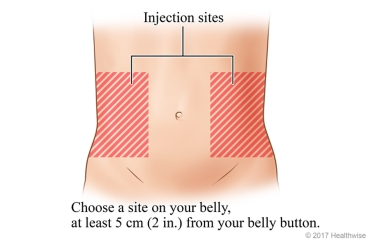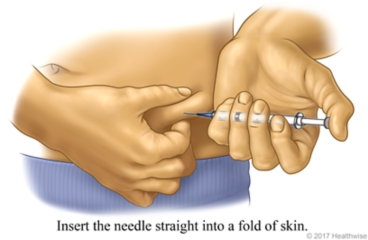Enoxaparin (Lovenox): Care Instructions


Overview
Enoxaparin (Lovenox) is an anticoagulant medicine. It is one of a class of anticoagulants called low molecular weight heparin. Many people call these medicines blood thinners. They don't actually thin the blood, but they increase the time it takes a blood clot to form. This reduces the chance of a blood clot in the leg veins (deep vein thrombosis) or in the lungs (pulmonary embolism).
Enoxaparin is a shot (injection). You or someone caring for you will inject it once or twice a day. Most people need shots for 5 to 10 days, but in some cases it can be longer. Your doctor will tell you how long you need to have the shots.
Enoxaparin is used to:
- Treat deep vein thrombosis (DVT), which is a blood clot in the legs, pelvis, or arms.
- Reduce the chance of getting blood clots after certain surgeries. For example, you may take enoxaparin after knee or hip replacement surgery.
- Reduce the chance of getting blood clots in people who are likely to get them and who are not active for a long period of time. For example, you may need enoxaparin if you need to stay in bed for a long time because of a health problem.
- Reduce the chance of blood clots when another blood thinner is stopped for a short time. For example, if you take warfarin and need surgery, your doctor may ask you to stop taking warfarin for a short time before the surgery. If you have a high risk of blood clots during this time, you may take enoxaparin before the surgery. After the surgery, your doctor will tell you when it is safe to start taking warfarin again. This is called bridge therapy.
Follow-up care is a key part of your treatment and safety. Be sure to make and go to all appointments, and call your doctor or nurse advice line (811 in most provinces and territories) if you are having problems. It's also a good idea to know your test results and keep a list of the medicines you take.
How do you safely inject an anticoagulant (blood thinner)?
Follow your doctor's instructions for how often to inject the medicine. Depending on what your doctor prescribed, you may give yourself a shot once or twice a day using prefilled syringes. Prefilled means that the syringes already have the medicine in them. Inject the medicine at the same time every day unless your doctor gives you other instructions.
Giving the shot
- Gather your prefilled syringe and an alcohol wipe or a cotton ball dipped in alcohol.
- Wash and dry your hands.
- Sit or lie in a position that lets you see your belly.
- Choose a site on the right or left side of your belly, at least 5 centimetres (2 inches) from your belly button.
- Clean the injection site with the alcohol wipe or cotton ball. Let it dry.
- Remove the cap from the needle.
- Hold the syringe like a pencil in one hand, keeping your fingers off the plunger. You may see an air bubble. It's okay. Unless your doctor tells you to, you don't have to remove the bubble.
- With your other hand, slightly pinch a fold of skin at the injection site between your fingers and thumb.
- Hold the syringe at a 90-degree angle to your skin so the needle is pointing straight at the injection site.
- Quickly push the needle all the way into the pinched-up fold of skin. Then push the plunger all the way in, so that the medicine empties out of the syringe. As you're giving the shot, keep holding the fold of skin so that you don't inject the medicine into muscle.
- Pull the needle straight out and let go of the skin.
- Point the needle away from you. Follow the manufacturer instructions for safely disposing of the needle and syringe. Don't use the same needle more than one time. Throw away the needle and the syringe in a safe place, such as a special container for needles.
- If you bleed a little, apply pressure over the shot area with your finger, a cotton ball, or a piece of gauze. To help avoid bruising, do not rub the area.
- Slightly change the spot where you give the shot each time you do it.
Being safe
- Call your doctor if you think you are having a problem with your medicine.
- Don't stop taking your medicine without talking to your doctor.
- If you miss a dose, call your doctor. Your doctor can tell you exactly what to do so you do not take too much or too little blood thinner. Then you will be as safe as possible.
- Check with your doctor or pharmacist before you use any other medicines, including prescription and over-the-counter medicines. Make sure your doctor knows all of the medicines and natural health products you take. Taking some medicines together can cause problems.
- Try to avoid injuries to help prevent bleeding. For example, be careful when you are exercising.
- Store your medicine at room temperature. Don't put it in the refrigerator or freezer.
When should you call for help?
Call 911 anytime you think you may need emergency care. For example, call if:
- You passed out (lost consciousness).
- You have signs of severe bleeding, such as:
- A severe headache that is different from past headaches.
- Vomiting blood or what looks like coffee grounds.
- Passing maroon or very bloody stools.
Call your doctor or nurse advice line now or seek immediate medical care if:
- You have unexpected bleeding, including:
- Blood in stools or black stools that look like tar.
- Blood in your urine.
- Bruises or blood spots under the skin.
- You feel dizzy or light-headed.
Watch closely for changes in your health, and be sure to contact your doctor or nurse advice line if:
- You do not get better as expected.
Current as of: July 31, 2024
